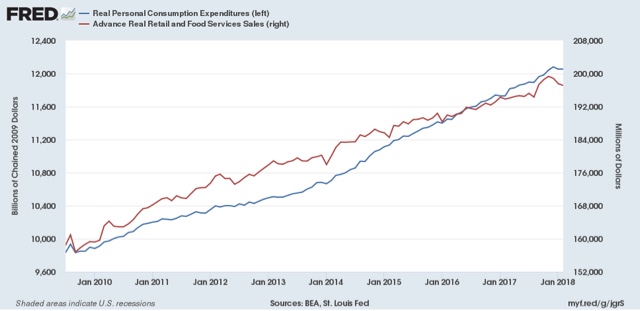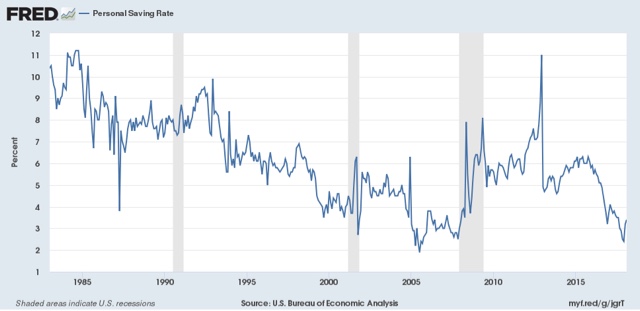Summary:
A note on personal income and spending Personal income and spending data from February intimates a weak Q1 GDP report, but doesn’t suggest any imminent downturn. The first graph below compares real personal spending with real retail sales: Real retail sales have pulled back from their autumn surge, and real personal spending has also declined slightly from its last peak in December. But we’ve had similar small drawbacks before, as in early 2012 and early 2014 without it portending anything horrible. Meanwhile the personal savings rate rose significantly: This metric tends to have a steep decline, as it did in 2016, sometime around the middle to late middle of an expansion. While a subsequent upturn in savings does occur in the advent of
Topics:
NewDealdemocrat considers the following as important: Taxes/regulation, US/Global Economics
This could be interesting, too:
A note on personal income and spending Personal income and spending data from February intimates a weak Q1 GDP report, but doesn’t suggest any imminent downturn. The first graph below compares real personal spending with real retail sales: Real retail sales have pulled back from their autumn surge, and real personal spending has also declined slightly from its last peak in December. But we’ve had similar small drawbacks before, as in early 2012 and early 2014 without it portending anything horrible. Meanwhile the personal savings rate rose significantly: This metric tends to have a steep decline, as it did in 2016, sometime around the middle to late middle of an expansion. While a subsequent upturn in savings does occur in the advent of
Topics:
NewDealdemocrat considers the following as important: Taxes/regulation, US/Global Economics
This could be interesting, too:
Joel Eissenberg writes How Tesla makes money
Angry Bear writes True pricing: effects on competition
Angry Bear writes The paradox of economic competition
Angry Bear writes USMAC Exempts Certain Items Coming out of Mexico and Canada
A note on personal income and spending
Personal income and spending data from February intimates a weak Q1 GDP report, but doesn’t suggest any imminent downturn.
The first graph below compares real personal spending with real retail sales:
Real retail sales have pulled back from their autumn surge, and real personal spending has also declined slightly from its last peak in December. But we’ve had similar small drawbacks before, as in early 2012 and early 2014 without it portending anything horrible.
Meanwhile the personal savings rate rose significantly:
This metric tends to have a steep decline, as it did in 2016, sometime around the middle to late middle of an expansion. While a subsequent upturn in savings does occur in the advent of recessions, the data is too noisy to say anything concrete.
I find it particularly useful to compare the YoY% change in real retail sales and real pesonal spending. Retail sales growth tends to outpace the more broad measure of personal spending earlier in expansions, and underperform later in expansions after the midpoint. That’s what we have now:
Almost certainly it was the autumn spurt in spending (possibly related to hurricanes and the fires in California) that was the outlier, rather than the subsequent several months.
BUT, note that the YoY% change in both has declined sharply in advance of the last several recessions. We don’t see that at all now. Real personal spending growth continues at roughly a 2.5% annual pace, and real retail sales growth at a 1.5% pace. While this is the umpteenth confirmation that we are later in the cycle, only if we see a deceleration to nearly or less than 0% change in YoY retail sales would I become concerned about any imminent downturn.



